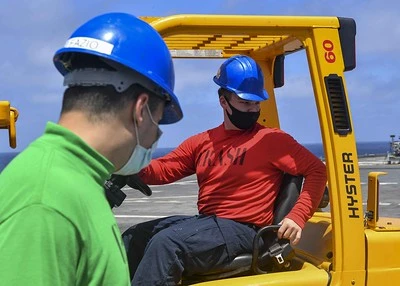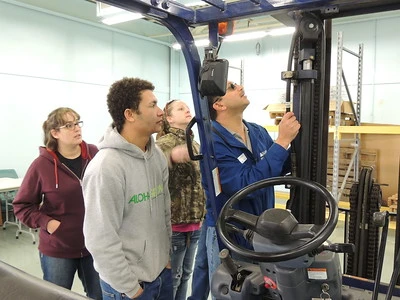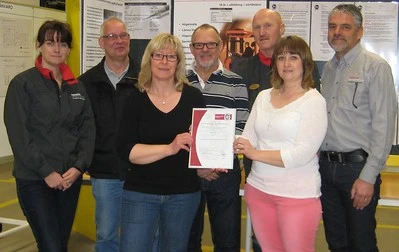Finding a Forklift Driving School & Taking The Class
May 16, 2024 | by onlineoshasafetytraining.com


Finding the right forklift driving school and taking the class can seem like a big task, but it’s easier than you might think. Whether you’re looking to start a new career or improve your skills, getting professional training is a smart move.
This guide will help you understand how to choose the best school and what to expect once you start your classes. Let’s get started on your journey to becoming a certified forklift driver!
Here Are What To Consider When Finding a School
1. Research Accredited Schools
- Explanation: Start by looking for schools that are accredited and recognized by industry standards. Accreditation ensures that the school meets specific quality criteria and that your certification will be valid.
2. Check Reviews and Recommendations
- Explanation: Read online reviews and ask for recommendations from friends, colleagues, or industry professionals. Honest feedback from past students can give you a good idea of what to expect.

3. Ask About the Curriculum
- Explanation: Make sure the school offers a comprehensive curriculum that includes both classroom instruction and hands-on training. It should cover all essential topics such as safety procedures, forklift mechanics, and OSHA regulations.
4. Evaluate the Instructors
- Explanation: Inquire about the instructors’ qualifications and experience. Skilled and knowledgeable instructors are crucial for effective training.
5. Consider the Class Size
- Explanation: Smaller class sizes can provide more personalized attention and better learning experiences. Ensure the school maintains a good instructor-to-student ratio.
6. Compare Costs
- Explanation: Training costs can vary widely, so compare tuition fees across different schools. Make sure you understand what’s included in the price and if there are any additional fees.
7. Look for Flexible Schedules
- Explanation: If you have other commitments, check if the school offers flexible class schedules, such as evening or weekend classes.
8. Ask About Financial Aid
- Explanation: Some schools may offer financial aid, scholarships, or payment plans to help with tuition costs. Explore these options if you need financial assistance.
Biggest Hurdle In Choosing a Forklift Driving School
The biggest hurdle in finding a forklift driving school is the quality of training because not all schools are created equal. You might end up feeling that the class doesn’t meet your needs for a career as a forklift driver.

Make sure the program the school offers is comprehensive and not rushed. You want thorough training that covers all the essential skills and safety protocols, allowing you to learn at a comfortable pace. A rushed program might skip important details, leaving you unprepared for real-world situations.
You want to make sure the school provides thorough, hands-on training with experienced instructors who know what they’re doing. It’s also important that the course covers everything you need to know, from basic operations to safety protocols.
OSHA has stated in its regulations that training must include both practical and classroom components. Make sure the program you choose offers hands-on practice with a forklift and classroom instruction. Both parts are essential for gaining the knowledge and skills needed to operate a forklift safely and effectively.
Make sure the class you’re taking is specific to the type of forklift you want to be certified in. Different forklifts have different controls and uses, so getting trained on the wrong type won’t help you much. Always check that the school offers training for the exact forklift you plan to operate in your job.
If the training is subpar, you could be unprepared for real-world challenges, making it harder to land a job or perform effectively in your role. So, it’s crucial to do your research and choose a school that offers high-quality training that truly prepares you for the job.
This Is How You Can Make Sure You’re Enrolling In The Right School
If you are going to find a forklift driving school and want to make sure it meets your standards, personally visit their premises. Observe their training facilities and get to know the instructors’ backgrounds. This will give you a better idea of the quality of training you can expect and whether the school is a good fit for your needs.
If circumstances permit, ask the school’s representative if you can visit and access the training facility. This way, you can see firsthand the equipment and environment where you’ll be learning, ensuring it meets your expectations and standards.
When you visit the training facility, here’s what to observe and why each is important:

- Quality of the Training Equipment
- The forklifts and other equipment should be in good working condition and up-to-date. This ensures that you are training on machines that are similar to what you will use in the workplace. Poor or outdated equipment can lead to improper training and even accidents during practice.
- Quality of the Training Facility
- The facility should be clean, well-maintained, and spacious enough for practical training. A clean and organized environment reflects the professionalism and commitment of the school to provide quality education. Adequate space is essential for safe and effective hands-on practice, allowing you to learn maneuvering and handling a forklift without constraints.
- Quality of the Training Curriculum
- The curriculum should comprehensively cover all essential topics, including safety procedures, operational techniques, and OSHA requirements. A well-rounded curriculum ensures that you gain the necessary knowledge and skills to operate a forklift safely and efficiently. It should include both classroom instruction and practical training to meet OSHA standards and prepare you for real-world scenarios.
Meet a Trainee If You Visit
If you meet a trainee during your visit, have a brief interview and ask them the following questions to get a better understanding of the training:
- How is the training going so far?
- This question provides a general sense of the trainee’s experience. It can give you a quick overview of their satisfaction and any immediate concerns or praises they might have about the program.
- How do you find the quality of the equipment and facilities?
- By asking about the equipment and facilities, you can gauge whether the school maintains its tools and environment to a high standard. Good quality equipment and well-maintained facilities are crucial for effective learning and safety.
- Do you feel the curriculum is thorough and covers everything you need to know?
- This question helps you understand if the training program is comprehensive. A thorough curriculum should cover all necessary topics, including safety protocols, operational techniques, and compliance with OSHA regulations, ensuring students are well-prepared.
- How are the instructors? Are they knowledgeable and helpful?
- Instructors play a key role in the learning experience. Knowing whether they are knowledgeable and helpful will inform you about the quality of teaching and support you can expect. Good instructors should be able to convey information clearly and assist students in understanding complex concepts.
- Is the pace of the training appropriate? Do you feel rushed or do you have enough time to learn?
- The pace of the training is critical to effective learning. If the training is too fast, students may not fully grasp important concepts; if it’s too slow, it could be a waste of time. This question will help you determine if the training schedule allows for adequate learning and practice time.
- Would you recommend this school to others? Why or why not?
- A trainee’s willingness to recommend the school is a strong endorsement of its quality. Their reasons for recommending or not recommending the school can provide valuable insights into its strengths and weaknesses, helping you make an informed decision.
You Know What, Everything Doesn’t Matter If You’re Not Going To Land a Job
So, make sure the school you choose has a job placement option. This ensures that you’ll have support in finding a job once you’ve completed the course, increasing your chances of starting your career as a forklift driver right away.
A good job placement program will have connections with local businesses and industries that hire forklift operators. They should help you with resume writing, interview preparation, and even setting up interviews with potential employers.
By choosing a school with strong job placement services, you’re not just learning how to drive a forklift; you’re also getting a head start on securing a job and building your career.
So, always ask about their job placement rates and the kind of support they provide to graduates. This will give you confidence that you’re making a smart investment in your future.
The Right School Has a Good Connection and Network in the Industry
A good forklift driving school has an extensive network and connections in the industry. This means they are well-connected with local businesses and industries that hire forklift operators. These connections can greatly enhance your chances of getting a job quickly after completing your training.
The school should leverage its network to help place graduates in relevant positions, ensuring you have access to job opportunities as soon as you are certified. This industry network is a crucial component of their job placement services, making your transition from training to employment much smoother.
When a school has strong industry connections, they often receive job openings directly from employers looking for trained forklift operators. This means you could have access to job listings that aren’t publicly advertised. Additionally, employers are more likely to trust and hire graduates from a school they have a good relationship with, knowing the quality of training provided.
Furthermore, these schools might invite industry professionals to give talks or conduct workshops, providing you with valuable insights and networking opportunities. They might also offer internships or on-the-job training placements, giving you hands-on experience and a foot in the door with potential employers.
So, when researching forklift driving schools, be sure to ask about their industry connections and job placement support. A school with a solid network and a proven track record of helping graduates find jobs can make a significant difference in starting your career as a forklift driver.
Taking the Forklift Certification Class
Classroom Instruction
Overview of topics covered (safety, mechanics, regulations):
- In the classroom, you’ll learn about forklift safety rules, how the machines work, and important regulations you need to follow. This foundational knowledge is crucial for understanding how to operate a forklift safely and legally.
Importance of understanding theoretical knowledge:
- Knowing the theory behind forklift operation is important because it helps you make better decisions when you’re actually driving. It’s not just about moving the machine; it’s about understanding why certain procedures and rules exist to keep everyone safe.
Hands-On Training
Practical exercises and operating different types of forklifts:
- Hands-on training involves practicing with actual forklifts. You’ll get to operate different types of forklifts, learning how to control them, move loads, and navigate different environments.
Safety protocols and real-world scenarios:
- During practical training, you’ll also learn safety protocols. This includes how to handle the forklift in various situations you might face on the job, ensuring you’re prepared for real-world challenges.
Instructor Guidance
Role of instructors in providing support and feedback:
- Instructors are there to help you learn. They provide support and give you feedback on your performance, pointing out what you’re doing well and what needs improvement.
Tips for making the most of your training sessions:
- To get the most out of your training, listen to your instructors, ask questions, and practice as much as you can. Their experience and advice are valuable resources for your learning process.
Evaluations and Exams
Types of assessments (written tests, practical exams):
- You’ll be assessed through written tests and practical exams. Written tests check your understanding of the theory, while practical exams evaluate your ability to operate a forklift safely and efficiently.
Strategies for successfully passing evaluations:
- To pass your evaluations, study the material thoroughly, pay attention during practical sessions, and practice regularly. Don’t hesitate to ask for help if you’re unsure about something – being well-prepared is key to success.
If You’ve Been Enrolled in a Bad School, We Recommend Taking Another Class
If you’ve been enrolled in a bad school, we recommend taking another class at a better school. It’s important to get proper training and certification to ensure you’re prepared for the job.
Don’t let a poor experience hold you back. Finding a reputable school with experienced instructors and a robust curriculum will make a significant difference in your skills and confidence. Look for a program that offers both classroom instruction and hands-on practice, ensuring you meet OSHA requirements and are fully prepared for the job market.
Remember to research thoroughly: visit potential schools, check their equipment and facilities, and talk to current students about their experiences. Ensuring the school has strong industry connections and job placement services can also provide a smoother transition into employment.
Don’t hesitate to invest in a quality program that offers comprehensive training, good facilities, and strong job placement support. Your future career as a forklift driver is worth it!
To Make a Conclusion
If you’re considering a career as a forklift driver, enrolling in a forklift driving school is a smart move. The right school will provide you with the skills and certification needed to operate a forklift safely and effectively. Plus, with job placement support, you’ll have a better chance of landing a job quickly.
By choosing a school with comprehensive training, good facilities, and strong industry connections, you’re setting yourself up for success. The benefits include not only becoming a certified forklift operator but also gaining access to job opportunities and a network of professionals in the field.
So, take the next step and look into enrolling in a forklift driving school. It’s a valuable investment in your future that can open doors to a rewarding career.
RELATED POSTS
View all


